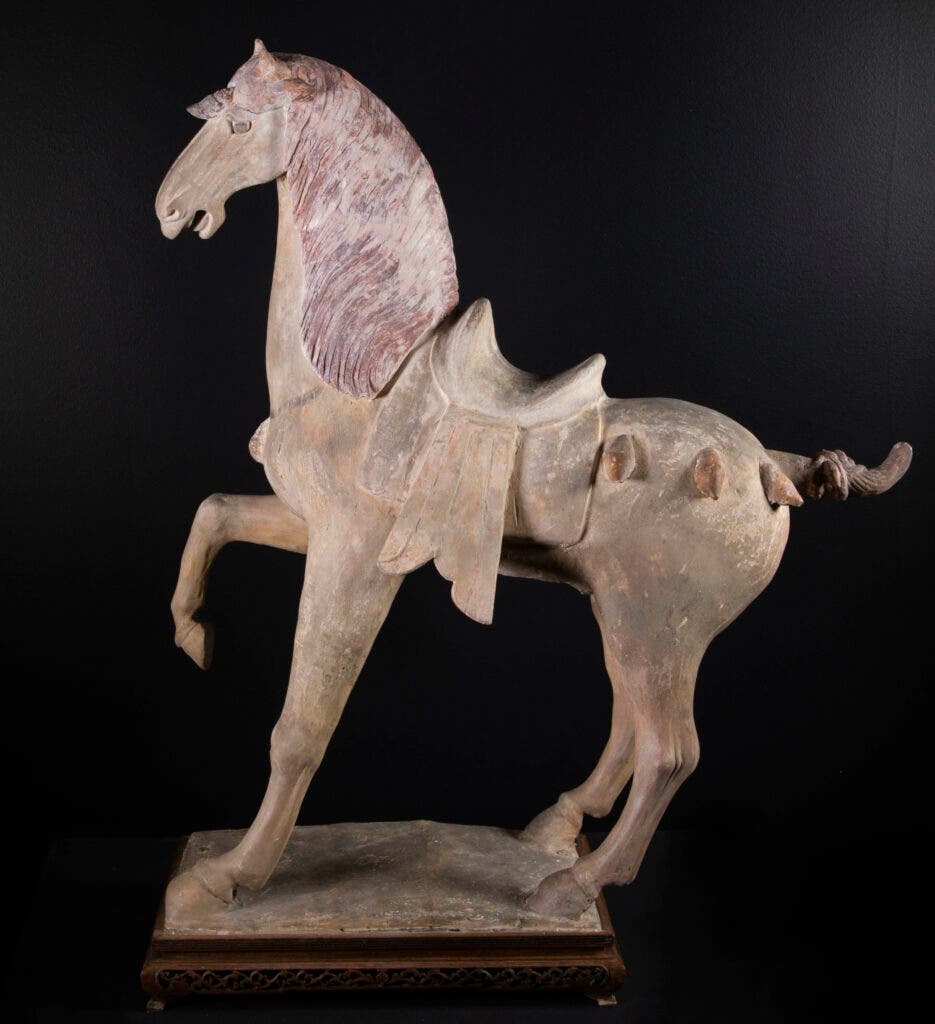A collaboration between art historians and researchers in Cincinnati has solved a 1,300-year-old mystery involving an imperial Chinese sculpture of a dancing horse.

Dancing horses have been a popular sight at the court of Imperial China. These animals were specifically trained to move in time with a drumbeat — essentially, dancing. Evidence of dancing horses performing for emperors dates as far back as 202 B.C.
One particular fan of them was Emperor Xuanzong from the eighth century who, historical accounts say, had a personal stable of over 40,000 horses. For one of his birthday celebrations, the Emperor once invited a troupe of 400 dancing horses to perform the “Song of the Upturned Cup.” So great was the popularity that these animals enjoyed at the courts of China’s emperors, that a tradition of commissioning sculptures of dancing horses to place in royal tombs began during the Tang dynasty.
The Cincinnati Dancing Horse
“During the dramatic finale, one horse would bend its knees and clench a cup in its mouth and offer wine to the ruler to wish him longevity,” says Hou-mei Sung, East Asian art curator at the Cincinnati Art Museum. “This became a ritual.”
The Cincinnati Art Museum received one such statue in 1997, as a donation from a private collector. The terracotta sculpture is some 1,300 years old and incredibly realistic with a very dynamic pose, but East Asian art curator Hou-mei Sung had doubts regarding its authenticity.
The main point of concern was a decorative tassel on the horse’s forehead which resembles a unicorn horn. Such an element is completely out of place on these statues, he explains, as no other dancing horse statue is known to have such tassels.
In order to determine the authenticity of the statue, the museum turned to the University of Cincinnati for help. Pietro Strobbia, a UC College of Arts and Sciences assistant professor of chemistry took up the task and set out to determine whether the tassel was part of the original work or added later on.
“Many museums have a conservator but not necessarily scientific facilities needed to do this kind of examination,” Strobbia said. “The forehead tassel looks original, but the museum asked us to determine what materials it was made from.”
The museum’s horse statue is saddled with a blanket and flowing silken material. Ten conical tassels complete the animal’s adornments. “The making of the sculpture is beautiful. These horses are renowned,” said Kelly Rectenwald, associate objects conservator at the Cincinnati Art Museum and co-author of the paper describing the analysis of the statue.
Despite her background in archaeology and chemistry, Rectenwald said the museum lacked the specialized equipment and knowledge needed to truly investigate the nature of the suspect tassel without damaging the statue. Strobbia, meanwhile, has always had a personal interest in art — so this was an ideal match from the get-go.
For the research, the museum agreed to allow Strobbia and his collaborators to take 11 tiny samples of the statue for analysis. This was a calculated risk-reward assessment by the Museum, Rectenwald explains.
These samples were examined using a host of molecular, chemical, and mineralogical testing methods. These included state-of-the-art approaches such as X-ray powder diffraction, ionic chromatography, and Raman spectroscopy.
According to the results, the tassel on the statue’s forehead was indeed not part of the original statue. It was made of plaster, not terracotta, and was added to the piece using animal glue.
Following the findings, the museum decided to remove the tassel to bring the artwork closer to its original state. Rectenwald reports that the area underneath the tassel was smooth and showed no signs of scoring, which is a typical occurrence beneath areas of sculptural adornments. Two other tassels on the horse were repaired at different times in its past, suggesting that there was ongoing interest in maintaining and restoring this sculpture over several centuries.
“It was restored at least twice in its lifetime,” Rectenwald said. “Finding anything new about an artwork is really interesting.”
The team hopes that the work they performed with this statue will be used to create analysis methodologies for other pieces at museums around the US.
The paper “Scientific investigation to look into the conservation history of a Tang Dynasty terracotta Dancing Horse” has been published in the journal Heritage Science.
Was this helpful?



